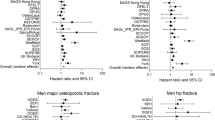Summary
Cross-sectional and case-control studies are efficient and inexpensive approaches to the study of osteoporosis; their validity depends primarily on how the subjects are sampled. Retrospective studies of fractures may be biased if measurements changes as a result of the fracture. Prospective cohort studies are less prone to such biases but are expensive. Randomized blinded trials are ideal for assessing studying single factors but trials are sometimes flawed by avoidable problems. Patient reports about risk factors are imperfect but sufficiently accurate to detect most strong associations between risk factors and osteoporosis. Noise in the measurement of risk factors will cause studies to underestimate the effect of these factors. About one-sixth of recalls of falls and fractures are incorrect. Self-report of vertebral fractures is unreliable and biased and there is controversy about how to define vertebral fractures on lateral X-ray film. Clinical and epidemiological research in osteoporosis would be advanced by greater care in the design of studies and methods of measurement.
Similar content being viewed by others
References
Hulley SB, Cummings SR (1988) Designing Clinical Research Williams and Wilkins, Baltimore, MD
Kelsey JL, Thompson WD, Evans AS (1986) Methods in Observational Epidemiology. Oxford University Press, New York
Rothman KJ (1986) Modern Epidemiology. Little, Brown, Boston Toronto
Weiss NS (1986) Clinical Epidemiology: the Study of the Outcome of Illness. Oxford University Press, New York
Hennekens CH, Buring JE (1987) Epidemiology in Medicine. Little, Brown, Boston Toronto
Recker RR, Heaney RP (1990) (Letter). J Bone Min Res 5:307–308
Horwitz RI (1987) The experimental paradigm and observational studies of cause-effect relationships in clinical medicine. J Chronic Dis 40:91–99
Mazess RB, Barden H, Ettinger M, Schultz E (1988) Bone density of the radius, spine, and proximal femur in osteoporosis. J Bone Min Res 3:13–18
Hlatky MA, Califf RM, Harrell FE, Lee KL, Mark DB, Pryor DB (1988) Comparison of predictions based on observational data with the results of randomized controlled clinical trials of coronary artery bypass surgery. J Am Coll Cardiol 11:237–245
Winkelstein W, Shilltoe EJ, Brand R, Johnson KK (1984) Further comments on cancer of the uterine cervix, smoking, and herpes virus infection. Am J Epidemiol 119:1–7
MacMahon S, Peto R, Cutler J, Collins R, Sorlie P, Neaton J, Abbott R, Godwin J, Dyer A, Stamler J (1990) Blood pressure, stroke, and coronary heart disease. Part 1, prolonged differences in blood pressure: prospective observational studies corrected for regression dilution bias. Lancet:765–774
Harlow SD, Linet MS (1989) Agreement between questionnaire data and medical records: the evidence for accuracy of recall. Am J Epidemiol 129:233–248
Paganini-Hill A, Ross RK (1982) Reliability of recall of drug usage and other health-related information. Am J Epidemiol 116:114–122
Horwitz RI, Yu EC (1985) Problems and proposals for interview data in epidemiological research. Int J Epidemiol 14:463–467
Goodman MT, Nomura AMY, Wilkens LR, Kolonel LN (1990) Agreement between interview information and physician records on history of menopausal estrogen use. Am J Epidemiol 131:815–825
Midanik L (1982) The validity of self-reported alcohol consumption and alcohol problems: a literature review. Br J Addict 77:357–382
Cummings SR, Block G, McHenry K, Baron RB (1987) Evaluation of two food frequency methods of measuring dietary calcium intake. Am J Epidemiol 126:796–802
Willett WC, Sampson L, Stampfer MJ, Rosner B, Bain C, Witschi J, Hennekens CH, Speizer FE (1985) Reproducibility and validity of a semiquantitative food frequency questionnaire. Am J Epidemiol 122:51–65
Byers T, Marshall J, Anthony E, Fiedler R, Zielezny M (1987) The reliability of dietary history from the distant past. Am J Epidemiol 125:999–1011
Washburn RA, Montoye HJ (1986) The assessment of physical activity by questionnaire. Am J Epidemiol 123:563–576
Williams E, Klesges RC, Hanson CL, Eck LH (1989) A prospective study of the reliability and convergent validity of three physical activity measures in a field research trial. J Clin Epidemiol 42:1161–1170
Cummings SR, Nevitt MC, Kidd S (1988) Forgetting falls: the limited accuracy of the history of falling in the elderly. J Am Geriatr Soc 36:613–616
Smith R, Cummings SR, Genant HK, Steiger P, Recker R (1987) Overdiagnosis of vertebral fractures: the need for vertebra specific criteria. In: Christiansen C, Johansen JS, Riis BJ (eds) Osteoporosis 1987. Norhaven Bogtrykhen, Viborg, pp 106–108
Hedlund LR, Gallagher JC (1988) Vertebral morphometry in diagnosis of spinal fractures. Bone Miner 5:59–67
Melton LJ, Kan SH, Frye MA, Wahner HW, O'Fallon WM, Riggs BL (1989) Epidemiology of vertebral fractures in women. Am J Epidemiol 129:1000–1011
Smith-Bindman R, Cummings SR, Steiger P, Genant HK (1991) A comparison of morphometric definition of vertebral fracture. J Bone Min Res (in press)
Author information
Authors and Affiliations
Rights and permissions
About this article
Cite this article
Cummings, S.R. Epidemiologic studies of osteoporotic fractures: Methodologic issues. Calcif Tissue Int 49 (Suppl 1), S15–S20 (1991). https://doi.org/10.1007/BF02555081
Issue Date:
DOI: https://doi.org/10.1007/BF02555081




